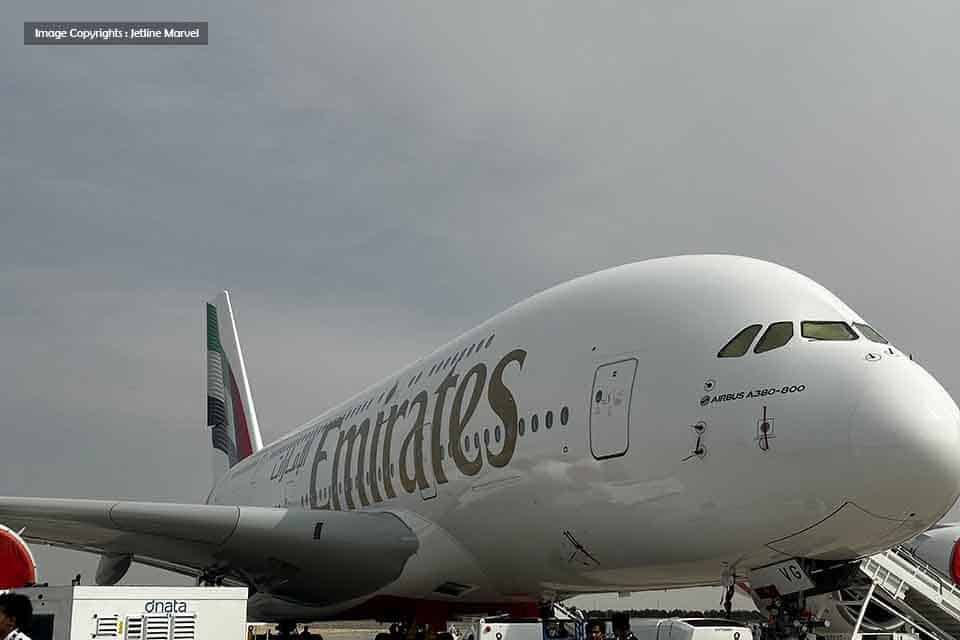Airlines
Oops: Emirates A380 Upper Deck Slide Deploys At Manchester Airport
The plane had arrived on a redeye from Dubai shortly before 7 a.m. and was scheduled to return to Dubai in just under two hours.

This event occurred on Emirates flight EK22, which was scheduled to depart From Manchester (MAN) to Dubai (DXB) at 8:50 a.m. on Monday, December 19, 2022. The flight was meant to be operated by an Airbus A380 with the registration code A6-EUN, which is about six years old. The plane had arrived on a redeye from Dubai shortly before 7 a.m. and was scheduled to return to Dubai in just under two hours.
Jet2 plane diverts to Bilbao so passengers could go to the toilet(Opens in a new browser tab)
Unfortunately while on the ground, the emergency slide connected to the forward left upper deck door deployed. Despite the jet bridge being pushed up to this door, this occurred.
Aside from the fact that Manchester Airport has declined to comment on the incident, it is believed that no one was injured in the incident.
Emirates has expressed regret to the travellers for the event and said the flight was “delayed owing to a technical issue.” A replacement plane from Emirates will be sent to Manchester, and it is scheduled to leave at 6 AM on December 20.
5 factors explain why the A380 is being scrapped. Does it justify it?(Opens in a new browser tab)
Photos posted by Dave Branson on Twitter showed the enormous 15-meter-long slide fully deployed with emergency workers looking on.
Incident at Manchester airport. Emirates emergency slide. pic.twitter.com/THIjsYHRac
— Dave Branson (@DaveBranson7) December 19, 2022
The slide that deployed is known as the U1 Left door since it is the first door on the upper deck and is located on the left side of the aircraft. The ramps are curved to reduce the possibility of panicked passengers freezing because the upper deck emergency exits are more than 25 feet above the ground.
The A380’s emergency slides are built to inflate in under four seconds, whereas emergency slides must be able to deploy and inflate in just six seconds. Once the deployment has begun, it cannot be stopped.
Although the exact cause of Monday’s accidental deployment in Manchester is unclear, the most frequent reason is that the cabin staff forgets to disarm the doors when they arrive.

Airlines
Air India to Launch aircraft maintenance training institute in Bengaluru

Air India, one of India’s leading global airlines, is set to establish a Basic Maintenance Training Organization (BMTO) in Bengaluru.
This institute will offer a comprehensive Aircraft Maintenance Engineering (AME) program certified by the Directorate General of Civil Aviation (DGCA). The program will follow an integrated 2+2 year structure, combining classroom learning with practical, hands-on training.
This initiative is part of Air India’s broader goal of creating a robust aviation ecosystem in India. With plans to expand its fleet and strengthen its operations, the airline aims to build a skilled workforce of maintenance engineers, making the organization self-reliant while supporting its ambitious transformation journey.
This country tops visa rejections in the popular Schengen countries
To bring this vision to life, air india has partnered with Bengaluru Airport City Limited (BACL), a subsidiary of Bangalore International Airport Limited (BIAL). Together, they will develop a state-of-the-art facility spanning 86,000 square feet at Bengaluru Airport City.
This purpose-built campus will feature modern classrooms, well-equipped laboratories, and qualified trainers to deliver world-class education and training. The institute is expected to become operational by mid-2026.
The BMTO will be located close to Air India’s new 12-bay Maintenance, Repair, and Overhaul (MRO) facility, also set to open in Bengaluru by early 2026. The AME program will begin with two years of academic coursework, followed by two years of practical training at the MRO, ensuring students receive hands-on experience adhering to industry standards.
Sanctions & Engine Issues Ground Half of Russia’s A320neo fleet
In the meantime, Air India has introduced a Cadet AME program in collaboration with reputable institutions in Bengaluru and Hyderabad.
This ensures continuity in its commitment to developing skilled aircraft maintenance engineers while the BMTO facility is under construction. The program also allows students to pursue a bachelor’s degree through university partnerships, enhancing their career and academic opportunities.
With this initiative, air india plane aims to address the growing demand for skilled professionals in aircraft maintenance and engineering, air india new planes contributing to the development of India’s aviation sector and creating specialized career paths for aspiring engineers.
-

 Aviation2 months ago
Aviation2 months agoMicrosoft Flight Simulator Raises $3 Million to Bring Back the An-225 Mriya
-

 Airlines2 months ago
Airlines2 months agoQatar Citizens Can Travel to the United States Without a Visa
-

 Aviation2 months ago
Aviation2 months agoQatar Airways bans these new Electronic Devices on plane
-

 Airlines2 months ago
Airlines2 months agoJapan Airlines Rolls Out Free Domestic Flights to International Passengers
-

 Defence2 months ago
Defence2 months agoWhich Country Has the Largest Fleet of Fighter Aircraft?
-

 Airport2 months ago
Airport2 months agoWestern Sydney Airport Welcomes Its First Plane After 6 Years of construction
-

 Travel2 months ago
Travel2 months agoQatar Airways Launches Four Additional Flights from Amsterdam
-

 Aviation2 months ago
Aviation2 months agoDid you know ? Once Boeing 747 carried 1088 passenger in 1991








